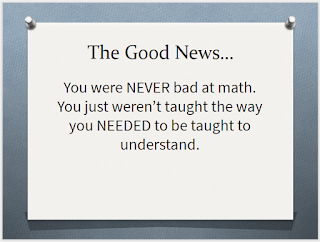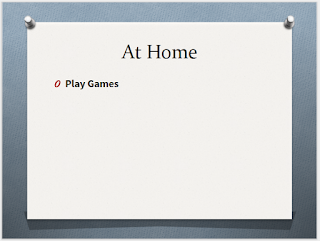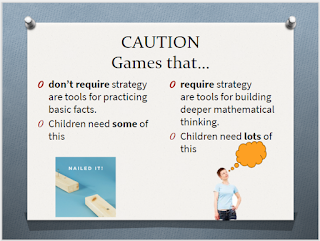The EMPL working group set one of the big ideas for Additive Thinking as
"Once students trust “the count”, they can flexibly manipulate numbers in order to make solving problems easier by
- using Parts and Wholes
- decomposing / Recomposing
- partitioning
- compensating
- using Constant Difference"
Additive Thinking is about being flexible with numbers. This big idea says that before they can be flexible with numbers, they must trust the count.
What is Trust the Count?
In order to explore this idea, you are going to engage in a little formative assessment. Don't worry. It's not going in your gradebook!
Look at the image below. How many dots are there? How do you know?
Now, click on the video below and watch the image change.
How many dots are there now? How do you know?
Click on the video below and watch it change again.
How many dots are there now? How do you know?
Let's take a moment to assess your responses.
For the first image, you might have counted out every dot. Maybe you saw the 5 dots on a dice in the center and one on each side. Or, did you see 1-2-1-2-1? Or, 3-1-3? Or, something else? How you figured out that there are 7 dots in the first image is irrelevant.
After you clicked and saw the first and second animations, how did you answer? Did you know it was still 7 dots or did you recount the dots? Someone who recounts all of the dots does NOT trust the count. They have not yet internalized the idea that the quantity stays the same if all you did was move them around.
This is a simple test that you can use when your students are struggling with operations. Use a quantity of items that they have not yet subitized - 9 is a good number for this. If they recount the dots, then stop everything you are doing and focus on helping build the idea of trusting the count. Operations on numbers will not make sense if they don't trust the count.
Students who don't trust the count are most likely missing mastery of the following grade 1 Alberta outcomes:
- Number outcome 2: Subitize (recognize at a glance) and name familiar arrangements of 1 to 10 objects or dots.
- Number outcome 3: Demonstrate an understanding of counting by
- indicating that the last number said identifies "how many"
- showing that any set has only one count
- using counting-on
- using parts or equal groups to count sets
- Demonstrate an understanding of conservation of number
So what do I do to help students trust the count?
These activities should be started in kindergarten when students are learning what numbers are all about and then continue on throughout the grade levels. Begin with the lowest level that makes sense for the student you are working with.
Activity 1:
Step 1: Place some objects in front of the student. Ask "how many are there?" Remember, it doesn't matter if they subitize or count each item. This step isn't about trusting the count. Ask "how did you know?" Did they count each one? Did they see groups of 2 and skip count? etc. Their skills here let you know if they are seeing the dots as individual pieces or can visualize grouping them together.
Step 2: Move the objects around the table. Ask, "how many are there now?" If they count each one, that's ok for now. Ask, "how do you know?"
Step 3: Move the objects around the table. Ask, "did I add any?" No. Ask, "did I remove any?" No. Ask, "how many are there now?" If they count each one, that's ok for now. Ask, "how do you know?"
Step 4: Move the objects around the table. Ask, "did I add any?" No. Ask, "did I remove any?" No. Ask, "Before checking, can you guess how many there are now?" It's ok if they are wrong or unsure of the answer. Say, "Let's check." Give them time to check. Ask, "how many are there now?" If they counted each one, that's ok for now. Ask, "how do you know?"
Repeat Step 4 several times but not too many times in a row. Spend about 5 minutes on this activity. Spending too long on it won't benefit them. It is better to spend smaller chunks of time on it but do it often. Don't change the quantity during a session, especially during these early stages.
Don't be surprised when (not if) at the end of a mini session, they are confidently repeating the number but then the next day, they are reverting back to counting each one several times. Building this idea takes time. Do...not...rush...this! I can not stress this enough.
Once students have done this activity with you a few times, you can have them work in partners, spreading the items out and pushing them tightly together but never changing the quantity.
Focus on building sense of very small numbers - 2 through 9 - before moving to larger numbers. Seriously, we rush this piece because we think students are getting it when they aren't there yet or that we have to get so far so fast. You have all the time in the world. Go slow.
CAUTION! I once had a teacher tell me that she did this activity with a student. She placed some objects in front of the student, had them figure out how many there were and then told the student to close his eyes! She rearranged the items, told the student to open his eyes and say how many there were. This is NOT about trusting the count. This is about trusting the TEACHER. They must KNOW that you didn't add anything or remove anything otherwise and they can only do that if they see you move the items.
CAUTION! I once had a teacher tell me that she did this activity with a student. She placed some objects in front of the student, had them figure out how many there were and then told the student to close his eyes! She rearranged the items, told the student to open his eyes and say how many there were. This is NOT about trusting the count. This is about trusting the TEACHER. They must KNOW that you didn't add anything or remove anything otherwise and they can only do that if they see you move the items.
Activity 2:
The situation: The student is subitizing all of the sides of a dice. They see six dots and say 6 without counting. They see 4 dots and say 4. When you show them a six and a four and ask them "how many are there in all?", they start counting each dot 1-2-3-4-5-6 7-8-9-10.
A different situation: You give them a word problem - There were 7 hot dogs ordered on Monday and 8 hot dogs ordered on Tuesday. How many hot dogs were ordered in all? They draw out the 7 hot dogs and then the 8 hot dogs and then count all - 1-2-3-4-5-6-7 8-9-10-11-12-13-14-15. This is a counting all strategy.
What do you do? Let's consider the dice showing six dots and four dots. Point to the six and ask "how many?" 6. Cover the six with your hand and ask, "how many?" If a student is unsure, lift your hand so they can see it. Make sure they understand that it's not a trick. You are not sneakily turning the dice while they can't see it. Cover the dice and ask "how many?" again. Repeat this, covering and uncovering until they confidently know that there is six under there. Again, be patient. The key word in the phrase "trust the count" is "trust". Trust always takes time to build. When they are confidently saying six, point to the first dot on the four and wait patiently. More often then not, they will say "one". Point to your hand covering the six and ask, "how many?" six. Point to the dot and say "sssssssssssssssssssssssseeeeeeeeeeeeeeeeeeeeeeeevvvvvvvvvvvvvvvvvvvvveeeeeeeeeeeeeeeeennnnnnnnnnn". Seriously, drag it out. If they say "seven" at any point while you are doing this stop and say "seven". If they don't, that's ok. They are probably looking at you like you have grown two heads but that's because they aren't sure where you are going with this. If they don't say 'seven" when you have dragged out saying it, just say "seven" yourself. The goal is for them to figure it out themselves but you may need to help a bit but not too much. You can point to your hand covering the six again and ask, "how many?" and then point to the first dot on the four and wait for a couple of seconds and, if needed, say "seven". Now, point to the second dot, wait a moment and then stretch out the word eight. Repeat this process until all four dots have been accounted for. Ask, "how many altogether?" Repeat the count if needed. Roll the dice again, and repeat this process.
This is called "Counting on". Students start with the total of one number (6) and then continue adding on from there. 6 -7-8-9-10. This is NOT an additive thinking strategy. It is a counting strategy but it will help move them towards additive thinking.
This is an activity students can do with partners once they understand it. Give them two dice and a cup. One student rolls the dice. The other student names them. The first student covers up one dice and the other student figures out how many. The first student checks to confirm.
You can also place a number of objects on the desk with a container that is big enough to cover many of them. Cover 5 of them and say, "There are five under the container. How many are there altogether?" When the student successfully counts on, uncover the container and check. Cover a different amount but don't change the total quantity. They might count on. They might add the two numbers. This helps build the understanding that you can separate a quantity into different parts but you still have the same quantity (trust the count). It also builds toward mastery of different addition facts. If a student is working on 9, and they see it as 1+8, 2+7, 3+6, 4+5, 5+4, 6+3, 7+2, 8+1 over and over again, they will add those facts to their basic fact toolbox.
This is an activity students can do with partners once they understand it. Give them two dice and a cup. One student rolls the dice. The other student names them. The first student covers up one dice and the other student figures out how many. The first student checks to confirm.
You can also place a number of objects on the desk with a container that is big enough to cover many of them. Cover 5 of them and say, "There are five under the container. How many are there altogether?" When the student successfully counts on, uncover the container and check. Cover a different amount but don't change the total quantity. They might count on. They might add the two numbers. This helps build the understanding that you can separate a quantity into different parts but you still have the same quantity (trust the count). It also builds toward mastery of different addition facts. If a student is working on 9, and they see it as 1+8, 2+7, 3+6, 4+5, 5+4, 6+3, 7+2, 8+1 over and over again, they will add those facts to their basic fact toolbox.
A student completing the hot dog question might still draw out 7 hot dogs and 8 hot dogs but, if they have mastered counting on, they will say 7 -8-9-10-11-12-13-14-15 OR 8 -9-10-11-12-13-14-15. If they are still counting all, point to the first 7 (or 8 - whichever they drew first) and ask if you have to count all of these hot dogs again. Draw a circle around all of them and write the number 7 below it. Cover up the image of the hot dogs but let the 7 show. Ask, "How many hot dogs are hidden here?" 7. Point to the 8th hot dog and repeat the same process completed above with the dice.
Teachers will often tell me that they tell students to put the first number in their head and then keep counting. This is great. Visualization is an extremely important skill. I do this AFTER they have had lots of time to understand it first with manipulatives. I find that this makes the transfer to visualization easier if they already have something to picture in their head.
Activity 3:
Here is one more mini assessment for students working with numbers higher than 20. Have them build 24 with base ten blocks using two tens and 4 ones. Then have them trade/exchange a ten for ten ones. Ask them what their new number is. You might be surprised how many might have to recheck. They've learned to trade; most do it automatically. However, they don't necessarily understand that the total value hasn't changed.
In a later blog post, I will be speaking a lot about place value and how to dig deeply into it. Alberta teachers, please remember that place value is currently introduced into the curriculum in grade 2. This is NOT an activity for grade 1 students.
A Support Document
Teachers will often tell me that they tell students to put the first number in their head and then keep counting. This is great. Visualization is an extremely important skill. I do this AFTER they have had lots of time to understand it first with manipulatives. I find that this makes the transfer to visualization easier if they already have something to picture in their head.
Activity 3:
Here is one more mini assessment for students working with numbers higher than 20. Have them build 24 with base ten blocks using two tens and 4 ones. Then have them trade/exchange a ten for ten ones. Ask them what their new number is. You might be surprised how many might have to recheck. They've learned to trade; most do it automatically. However, they don't necessarily understand that the total value hasn't changed.
In a later blog post, I will be speaking a lot about place value and how to dig deeply into it. Alberta teachers, please remember that place value is currently introduced into the curriculum in grade 2. This is NOT an activity for grade 1 students.
A Support Document
The EMPL group created a document (just scroll down a bit after following the link) explaining "trust the count", some misconceptions about number sense, and everything I have outlined above plus more. It can be printed and sent home to parents if you wish.
Source
Trusting the count is something we have internalized ourselves and we may be surprised by how many students come into classrooms without this understanding. For me personally, I know that I was playing board games and card games all the time before I even started Kindergarten. I was already subitizing. I could count on. These activities had me playing with numbers all the time. Now, I watch students come into school who have grown up on devices instead of on physical games. Many of them are coming in never having played a board game or pulled out a deck of cards. I can't control what happens before they get to me. I make sure they get all of those experiences in my class. We play lots of board games, card games and dice games. I try to make sure we spend at least 5 minutes every day on a game.
Self Reflection question for you: What strategies have you used to support students who do not trust the count?






































